7.3 Embellishing Tones: Tutorial
Non-chord Tones (NCT)
Non-chord tones (also called non-harmonic tones or embellishing tones), are pitches that are not members of a chord. When analyzing music, NCTs are not included in the Roman Numeral labels for chords. NCTs are used to decorated and embellish, expand lines, provide interest, and create motion. They can be accented or unaccented, diatonic or chromatic, and ascending or descending. We often group NCTs by how they are approached and left between chord tones.
NCTs that are approached and left by step
Passing tones (PT)
A passing tone fills the space between two notes. It can be accented or unaccented, diatonic or chromatic, and ascending or descending. More than one passing tone can be used in a row to fill in the space between chord tones.
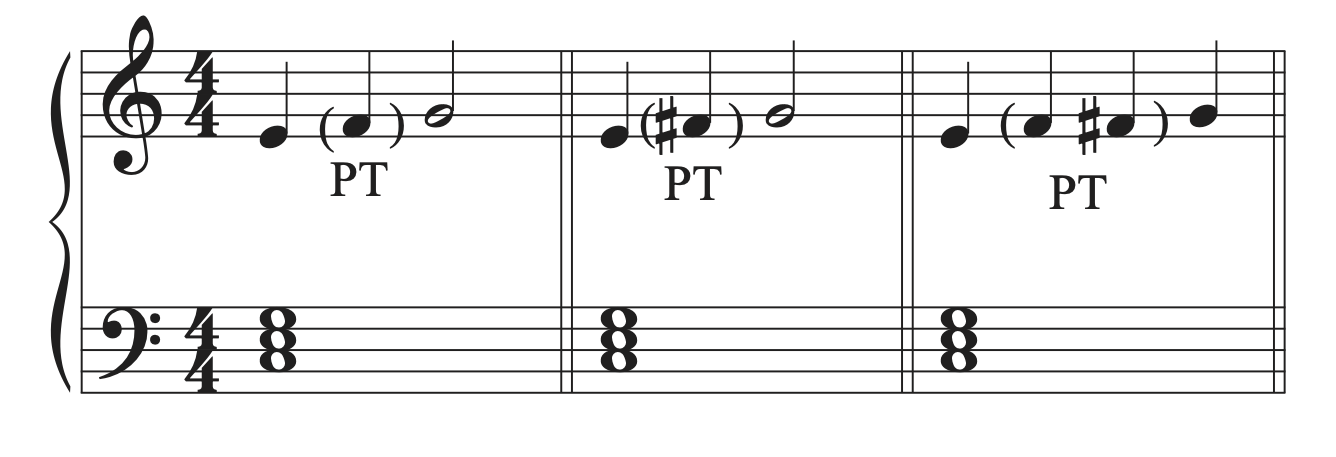
Neighbor tones (NT)
Neighbor tones embellish a single tone, which is heard before and after the Neighbor tone. Neighbor tones can be upper or lower, diatonic or chromatic, and accented or unaccented.
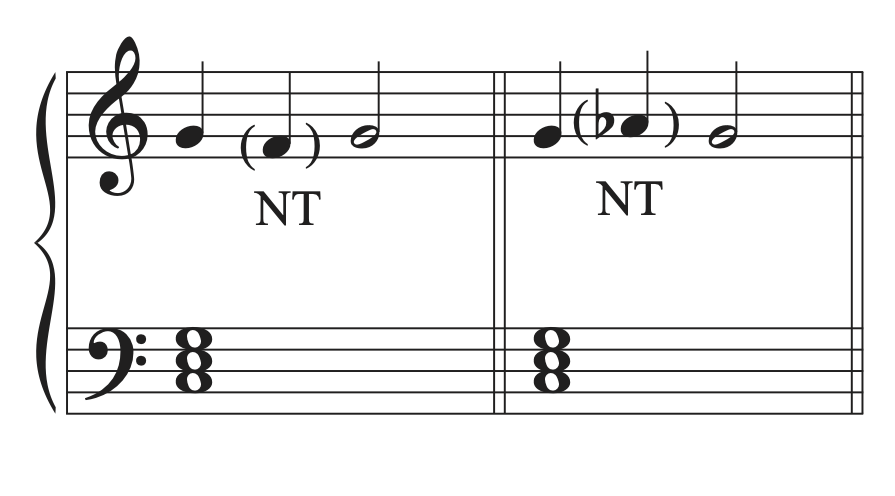
NCTs that are approaching and left with a step then leap, or a leap then step
Double Neighbor tones (DN)
Double neighbor tones are also called enclosures, cambiatas, changing tones, or neighbor groups. Double neighbors decorate a single note and form from using two neighbor tones in succession (either lower neighbor followed by upper neighbor or upper neighbor followed by lower neighbor)
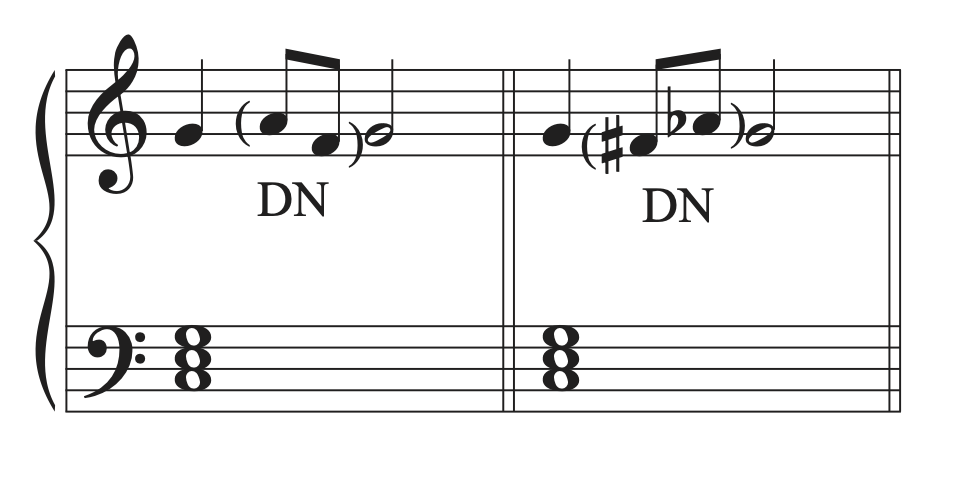
Appoggiaturas (APP) and Incomplete Neighbors (IN)
Appoggiaturas and Incomplete neighbors are both approached by leap and resolved by step (most often in the opposite direction as the leap). Incomplete neighbors fall on an unaccented part of the beat in comparison to the resolution note that follows them. Appoggiaturas fall on an accented part of the beat in comparison to the resolution note that follows them. It is easy to mix these two up, so make sure to always check to see if the NCT or the following resolution note are stronger. The chart below shows the strong beats or parts of the beat on which an APP can be placed and the weaker beats or parts of the beat on which an IN can be placed.
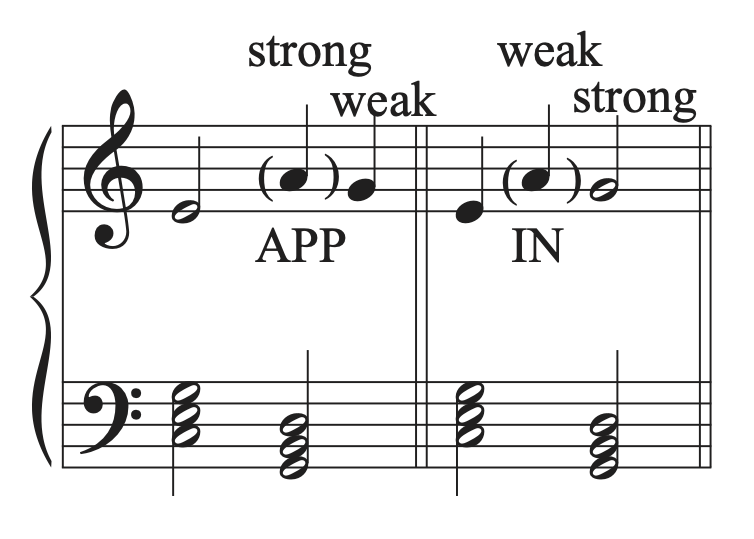
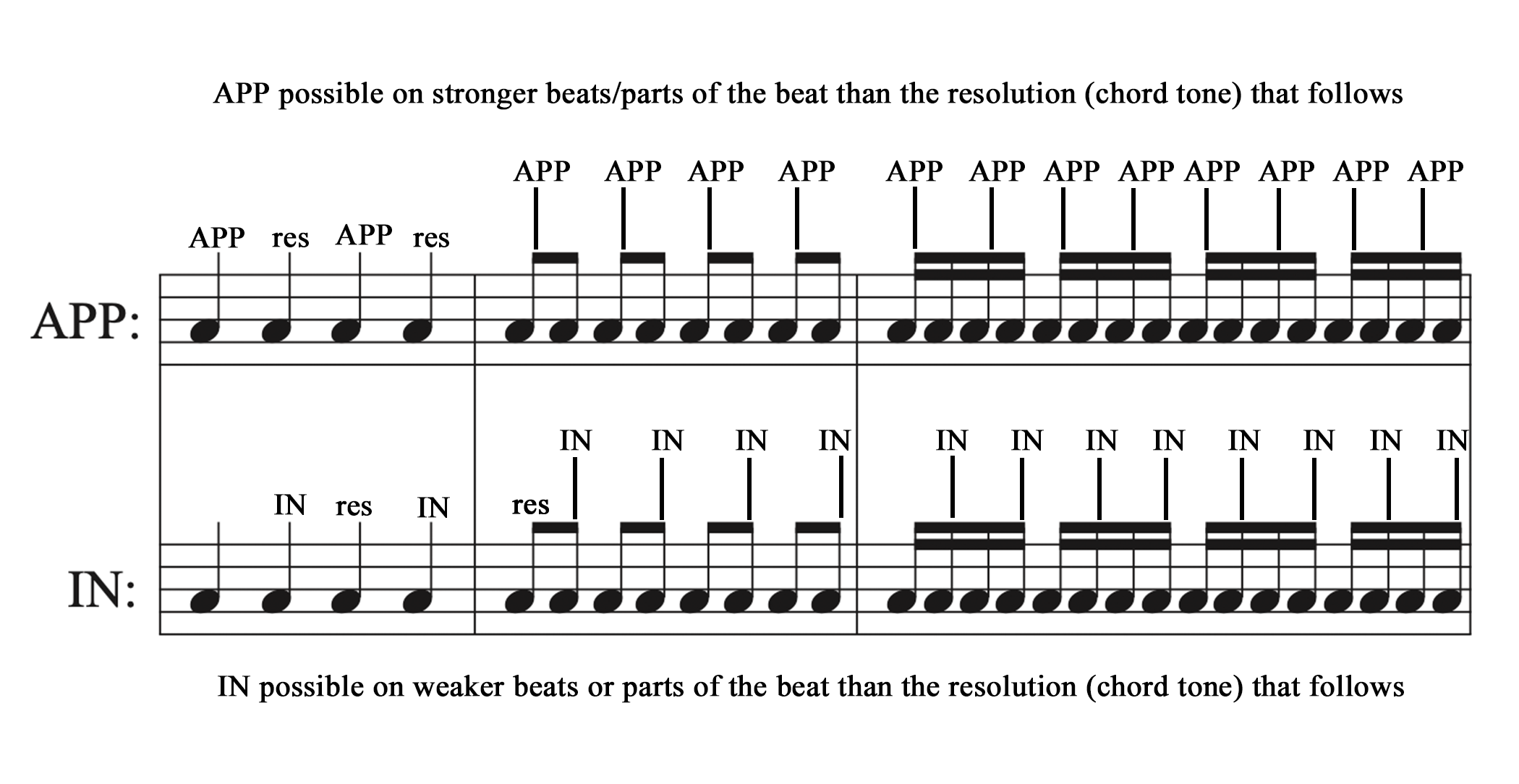
Escape Tones (ET)
Escape tones are approached by step and left by leap (most often in the opposite direction). They are usually unaccented.
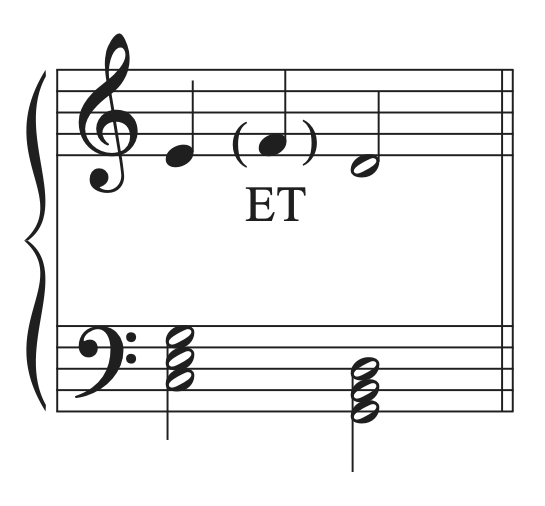
NCTs that use step-repetition motion
Anticipations (ANT)
An anticipation is a member of the next chord that arrives earlier than the rest of the chord. Because it arrives before the chord changes, it is a NCT with the chord it aligns with. Anticipations most often remain on the same note to become a chord tone when the next chord finally arrives. Anticipations are common at cadences, but can be found in other places as well.
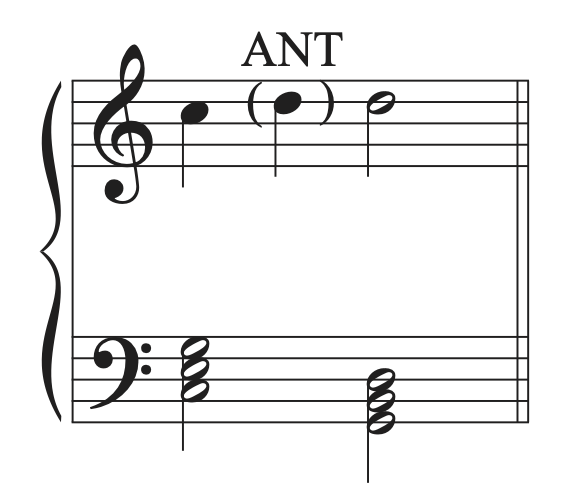
Pedal Tones (PED)
Pedal tones derive their name from their frequent use in organ music because they were held using the foot pedals on the organ. A pedal tone is a long note that is sustained while the harmonies change around it.

Pedal tones are often found in the bass, but can be in any voice. When analyzing music with a pedal tone, write PED in the score when the note becomes an NCT. Then disregard that note during the rest of the chordal analysis. Pedal tones on tonic were often used to establish the key at the start of a piece. Pedal tones on dominant were used even more frequently to signal that the final cadence was coming. A great example of a pedal tone is J. S. Bach’s Prelude and Fugue BWV 540. Watch this video to hear how long the pedal lasts: Toccata & Fugue in F Major
Suspensions (SUS)
A suspension happens when a note from the previous chord is held over when the rest of the chord changes. It resolves down by step. Suspensions occur on accented parts of the beat.
A suspension is made of three parts:
- Preparation (prep): the note in the previous chord that is the same pitch as the suspension
- Suspension (sus): the dissonant note following the preparation. It is the note that is held over when the rest of the chord changed. It can be tied to the preparation note or articulated.
- Resolution (res): the note following the suspension. All suspension notes resolve down by step to the resolution note.
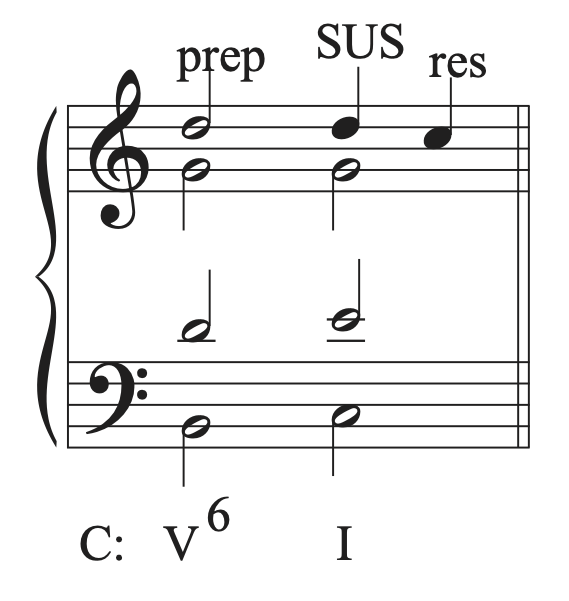
Naming suspensions
- Suspensions are named according to harmonic intervals created by the suspension note and by the resolution above the bass pitch. The intervals are always name as simple intervals, even if the intervals are larger than an octave.
- Common suspension types:
- 9-8 or 2-1 if the suspension resolves to a unison with the bass (upper voice suspension)
- 7-6 (upper voice suspension)
- 4-3 (upper voice suspension)
- 2-3 (only suspension that occurs in the bass; cannot occur in the upper voices. It gets its name because one of the upper voices will form the intervals 2-3 with the bass when the suspension resolves.)
Suspensions with a change in bass
Suspensions with a change in the bass occur when the bass moves to another note at the same time that the suspension resolves. They can also occur in an upper voice in a 2-3 bass suspension when the upper voice changes notes when the bass resolves. These suspensions are still named for the interval between the suspended note and the bass followed by the interval between the resolution and the bass.

Consonant suspensions
While most suspensions are dissonant, it is possible to have a consonant suspension. While the suspended note is a non-chord tone, it does not create dissonance with the chord.
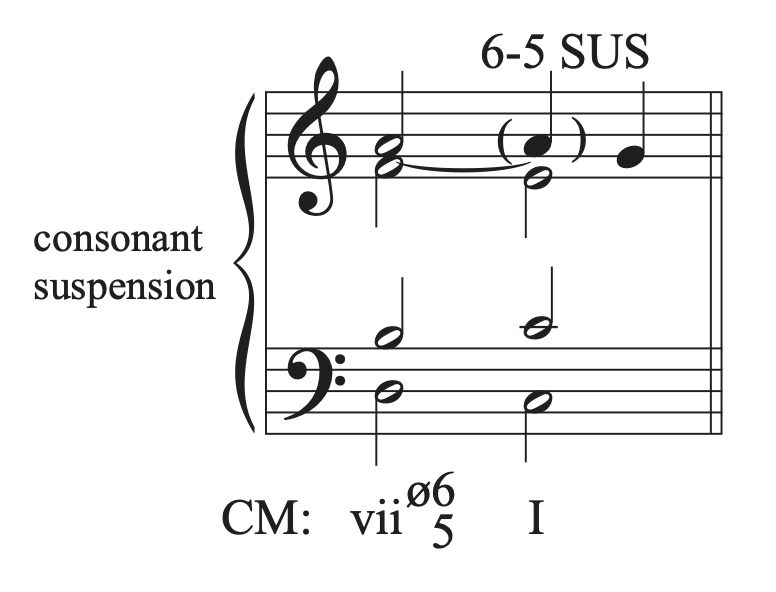
Embellishment of suspensions
Suspensions can be embellished between the suspended note and the resolution.
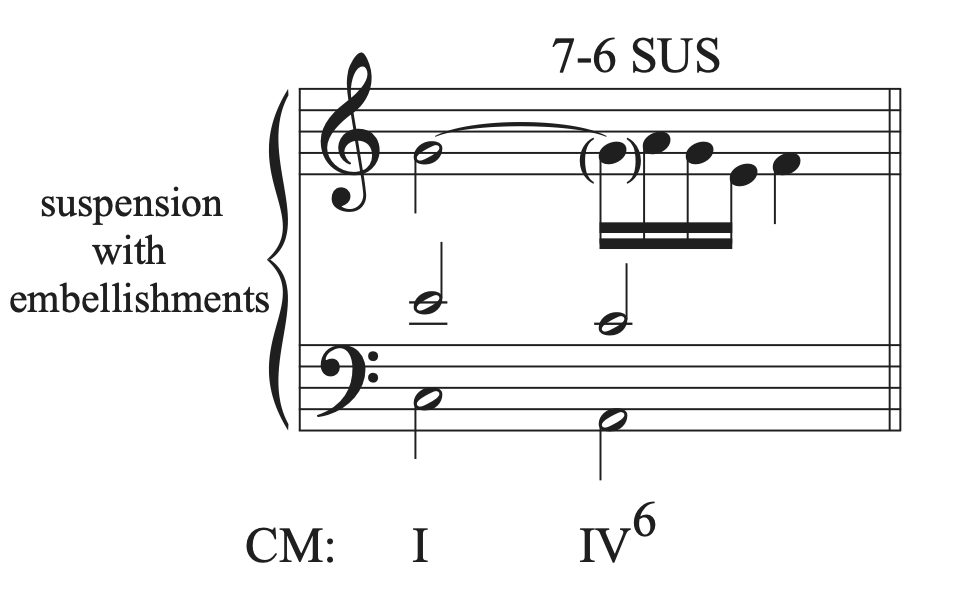
Chain of suspensions
Suspension chains happen when the resolution of one suspension serves as the preparation for the next suspension.
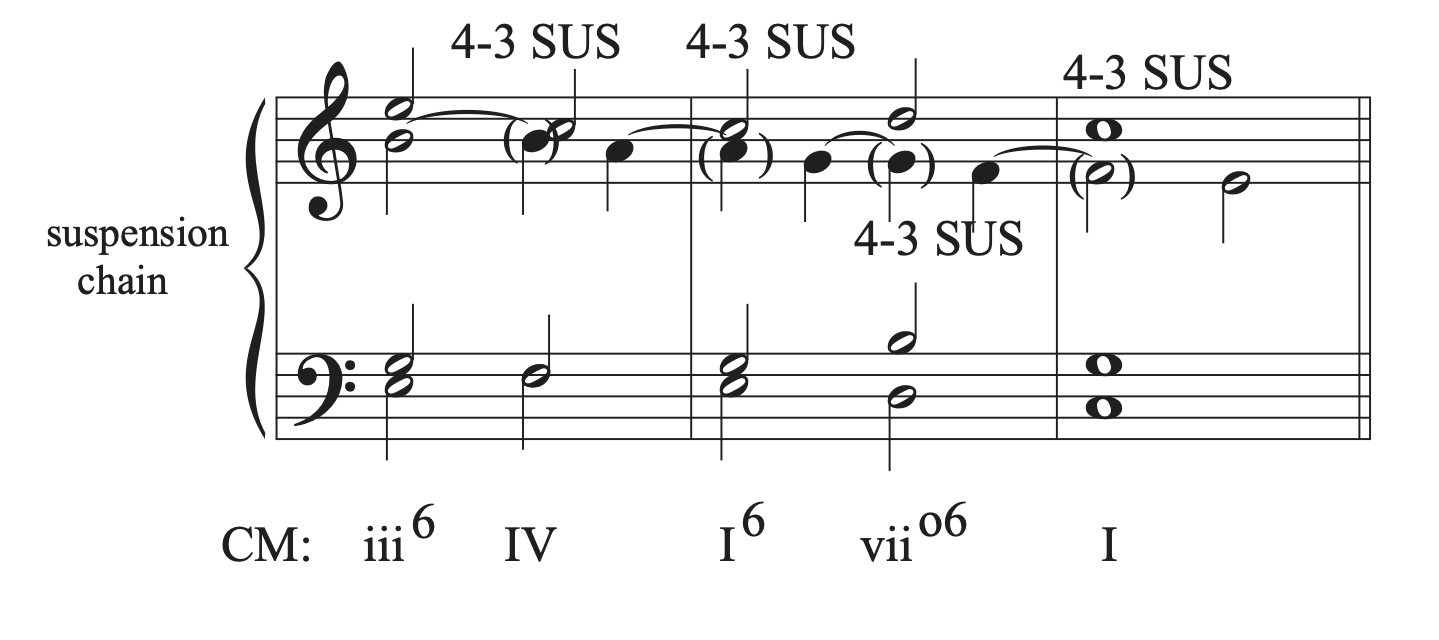
Retardations (RET)
- Retardations are like suspensions, but they resolve up by step instead of down by step. Unlike suspensions, they are not named with specific numbers.

Labeling NCTS
During analysis, any notes that are not part of the chord should be put in parenthesis in the score and labeled with the type of NCT. Put the label close to the parenthesis. Make sure only put NCTs in parenthesis. Chord tones should be included in the analysis.
Common mistakes made when drawing and labeling NCTs
- Labeling a chord tone as a non-chord tone. A non-chord tone is a note that is not in the chord. When inserting NCTs into a passage, always double check that the NCT is not actually a chord tone.
- Not labeling the NCT properly. The parenthesis goes around the actual NCT (no other notes) and there must be a label to show what kind of NCT it is.
- Rhythm must be accurately drawn so that each bar has the correct number of beats. Make sure all beats line up vertically. This is especially important on NCTs that must be inserted onto strong beat or parts of the beat, like appoggiaturas and suspensions.
- Be careful not to mix up Appoggiaturas (strong beat/part of the beat) vs. Incomplete Neighbor (weak beat/part of the beat)
Look at the music you are currently practicing or studying. How many NCTs can you find? What would the music sound like without them? Write out a version without the NCTs and compare the two. Was is gained by looking at the structure of the music without the NCTs? What is lost by leaving them out? Think about how the NCTs are used in your music. Which ones create forward motion (think of the ones with motion between note, like passing tones) and which ones create small pauses during which you can hear certain notes more prominently (like neighbors, appoggiaturas, and suspensions, for example). Reflect on how understanding the specific NCTs in your music has changed your experience playing and listening to the piece.

